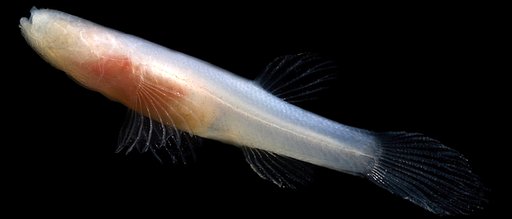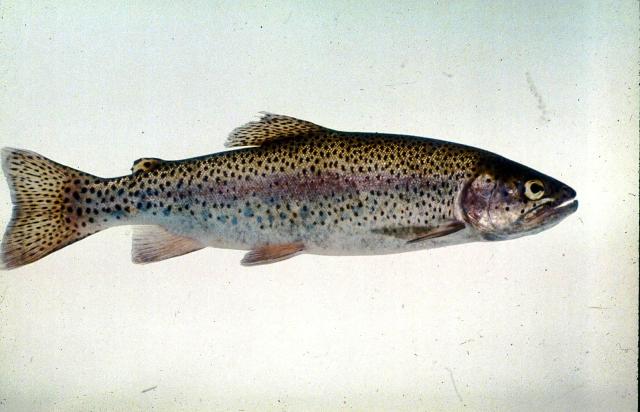
Interactions with Other Species
In the underground caves where A. rosae are found, there
are very few predatory species that the cavefish have to worry
avoid. However, one species in particular that they must be wary of
is the banded sculpin (Cottus carolinae) (Brown & Johnson,
2001). The banded
sculpin is primarily found around the mouth of the cave system and
other sections of the aquifer that exit into small stream systems.
 The sculpin primarily feeds on
mayflies
and other small insects, including crayfish that are widespread in the caves, but
if the opportunity presents itself, they have been observed preying
upon the Ozark cavefish. With a maximum size approaching five inches
(recall that the cavefish reaches a maximum size of around 2 inches),
the cavefish provides a perfect meal for the banded sculpin (Brown &
Johnson, 2001). The Ozark cavefish is a carnivorous fish that feeds
on amphipods and copepods (small crustaceans that are endemic to
this environment), and salamanders (Brown & Johnson, 2001).
The sculpin primarily feeds on
mayflies
and other small insects, including crayfish that are widespread in the caves, but
if the opportunity presents itself, they have been observed preying
upon the Ozark cavefish. With a maximum size approaching five inches
(recall that the cavefish reaches a maximum size of around 2 inches),
the cavefish provides a perfect meal for the banded sculpin (Brown &
Johnson, 2001). The Ozark cavefish is a carnivorous fish that feeds
on amphipods and copepods (small crustaceans that are endemic to
this environment), and salamanders (Brown & Johnson, 2001).
Above: An image of the banded sculpin (Cottus carolinae) found in Cave Springs and Logan Caves. Image courtesy of the United States Fish and Wildelife Service.
It has been recorded that catastrophic weather events such as
flooding and extreme weather changes can have very negative effects
on the behavior patterns of the Ozark cavefish (Noltie & Wicks,
2001). If the flooding is
severe enough, the cavefish shows a high level of disorientation and
it has been noted attempting to exit the cave system (Greaning et
al., 2010). When this
happens and the fish enters into the small tributary streams that
run out of the caves, they can often become the prey of the rainbow
trout (Oncorhynchus mykiss). Due to the cold nature of the
water that is exiting the cave system, the outflowing streams create
a very conducive environment for the trout, of which their diet
consists mostly of smaller fish species (Graening et a l., 2010).
l., 2010).
Above: an image of a rainbow trout (Oncorhynchus mykiss). This species invasive species is being introduced into the cave systems that are inhabited by A. rosae. Image courtesy of the United States Fish and Wildelife Service.
An unfortunate side effect of the natural beauty of these cave systems is the increased interest in creating a tourist industry for them. Some of the locals who are attempting to create a more enticing attraction have brought these invasive trout species directly into the cave aquifers themselves (Greaning et al., 2010). This causes many problems in the local ecosystem; not only does this result in the increased predation of the cavefish, but it also introduces a new elite predator that inserts itself at the apex of the food chain (Graening et al., 2010).
Another problem that was also introduced when the rainbow trout were stocked in the aquifers is the fact that they carried parasites with them. It is currently known that these parasites have the ability to infect A. rosae, but due to the fact that this is a relatively recent problem, the effects on the population, as a whole, are not well understood (Graening et al., 2010).
 The Ozark cavefish has formed a unique relationship with another
organism that resides in the cave ecosystem, the grey bat (Myotis
grisescens). The cavefish is regularly found in greater
concentrations where the grey bat roosts at night, and there are
several reasons as to why this occurs (Greaning et al., 2010). To begin with, the cavefish
feeds directly on the droppings of the grey bat as they fall into
the water. Also, the most influential effect that the grey bat has
on the presence and health of the cavefish population is the fact
that many other organisms in the aquifers feed on the droppings as
well. This is very important for the cavefish because the amphipods
and copepods that make up the majority of their diet feed almost
exclusively on the droppings of the grey bat (Graening et al.,
2010). A similar species to the grey bat is the
spectral bat (Vampyrum spectrum), which is also located
in many North American caves.
The Ozark cavefish has formed a unique relationship with another
organism that resides in the cave ecosystem, the grey bat (Myotis
grisescens). The cavefish is regularly found in greater
concentrations where the grey bat roosts at night, and there are
several reasons as to why this occurs (Greaning et al., 2010). To begin with, the cavefish
feeds directly on the droppings of the grey bat as they fall into
the water. Also, the most influential effect that the grey bat has
on the presence and health of the cavefish population is the fact
that many other organisms in the aquifers feed on the droppings as
well. This is very important for the cavefish because the amphipods
and copepods that make up the majority of their diet feed almost
exclusively on the droppings of the grey bat (Graening et al.,
2010). A similar species to the grey bat is the
spectral bat (Vampyrum spectrum), which is also located
in many North American caves.
Above: An image of the gray bat (Myotis grisescens) roosting inside of a cave. Image courtesy of the United States Fish and Wildelife Service.